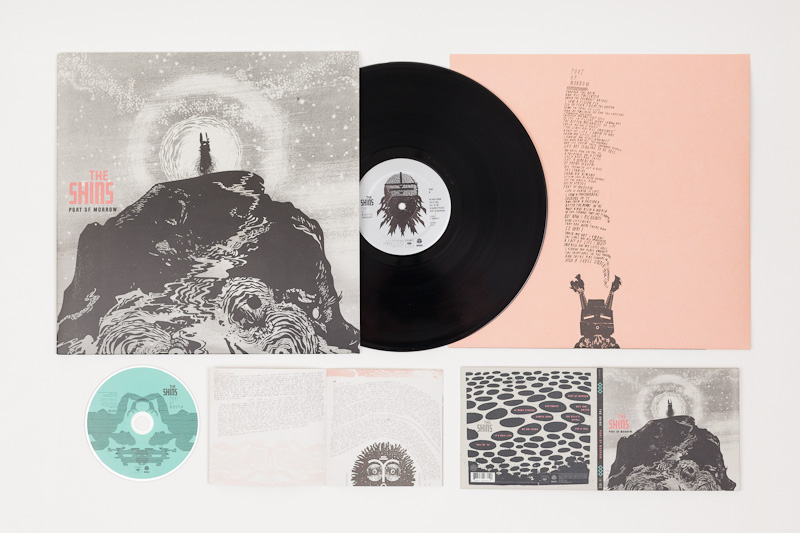Leisa Rich is an Atlanta-based textile and mixed-media artist originally from Ontario, Canada. Upon 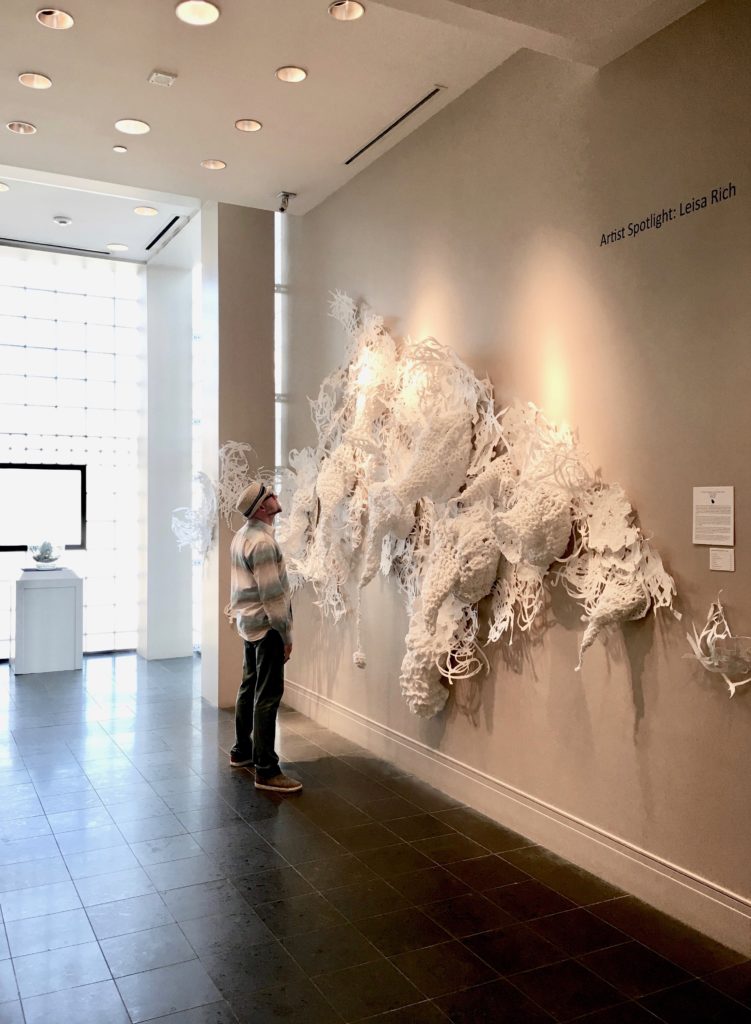 making this city her home 12 years ago, Leisa paved her artist path through experimentations with recycled materials such as threads and plastic. Most recognizable in Leisa’s work are the intricate details, an abundance of color, and design structures that take their cue from nature. With every installation, Leisa (also a published author) invites her audience to interact with her works of art and provides a feast for the senses.
making this city her home 12 years ago, Leisa paved her artist path through experimentations with recycled materials such as threads and plastic. Most recognizable in Leisa’s work are the intricate details, an abundance of color, and design structures that take their cue from nature. With every installation, Leisa (also a published author) invites her audience to interact with her works of art and provides a feast for the senses.
Leisa implores an array of techniques and tools to create her textiles pieces. She incorporates fabric dyeing, sewing, painting, burning, melting, hand-embroidering, and even 3D printing in her work. Here, Leisa shares with CommonCreativ how art came into her life, her fascination with fabrics, and how she continues to push the boundaries of experimentation.
CommonCreativ: How did you decide to pursue art?
Leisa Rich: I’ve always said that art truly chose me. My creative precociousness began early on as a young child. In the first grade, I attended a Catholic school, Our Lady of Mercy in Sarnia, Ontario. During class one day, my teacher Sister Mary happened to see one of my drawings, which sparked great concern. Immediately I was removed from the class and sent home midday with a note to my parents.
Equally perplexed and shamed from embarrassment I walked the mile home and hesitantly gave my mother the sealed letter from Sister Mary. Upon opening the letter my mothers look went from horrified to humorous. The concerned note from my teacher explained that I had been drawing nudes during class. The following morning my mother met with the school faculty to explain that the drawings I made were actually replications of a cartoon wallpaper in our downstairs bathroom. Shortly thereafter the wallpaper with the nude ladies bathing and showering was replaced.
I officially became an artist in 1975 while in the 10th grade. At that time I attended a private boarding school for the fine arts near Traverse City, Michigan. For many years I had been a dancer and was struck with an illness which caused me to put on weight. Sadly, I was kicked out of the dance program and wouldn’t be allowed back until I lost the additional weight. The temporary opening in my school schedule led to attend a weaving class on a friends recommendation that it was “an easy A.” I never expected to continue the course beyond the two months left in the semester. However, by the third day of weaving class, I was enamored. It was at that time in my life that I found my passion.
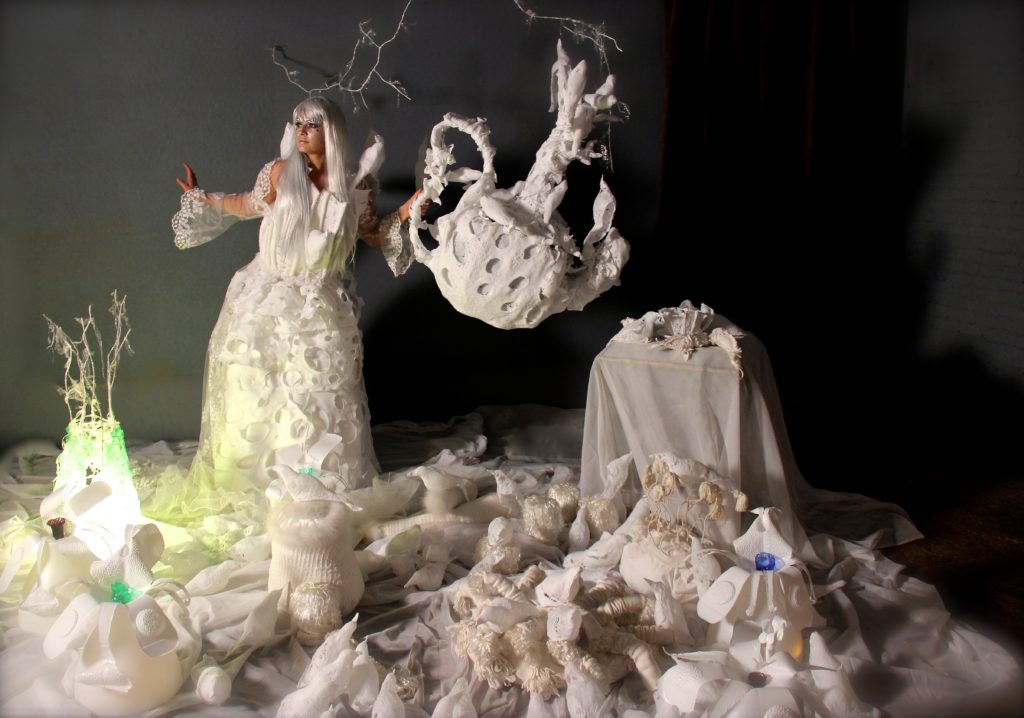
CC: What brought you to Atlanta?
LR: After completing grade school I attended the University of Michigan and graduated in 1982 with a BFA. Just a few years later I was in a dance club back in Canada, where I met my soon-to-be husband, a young American man. Together we lived in Canada for some time, then moved all across the USA from Hawaii to Texas. Then in 2005, my husband’s career brought us to Atlanta.
The interesting thing is, when I was moving here, I discovered that I am a descendent of the Walker family, who owned and then sold the land that is now Piedmont Park in 1904 to the City of Atlanta. I also learned that my grandfather and great-grandmother were born on that land. So, I am really a descendent of Atlanta. Additionally, many of my relatives were buried on the land where now stands [an] apartment building across from the front gates to the park. Their bodies were exhumed, moved, and split between Rock Spring Cemetery and Oakland Cemetery. It seems I was destined to come to Atlanta.
CC: What did Atlanta’s arts scene look like when you arrived?
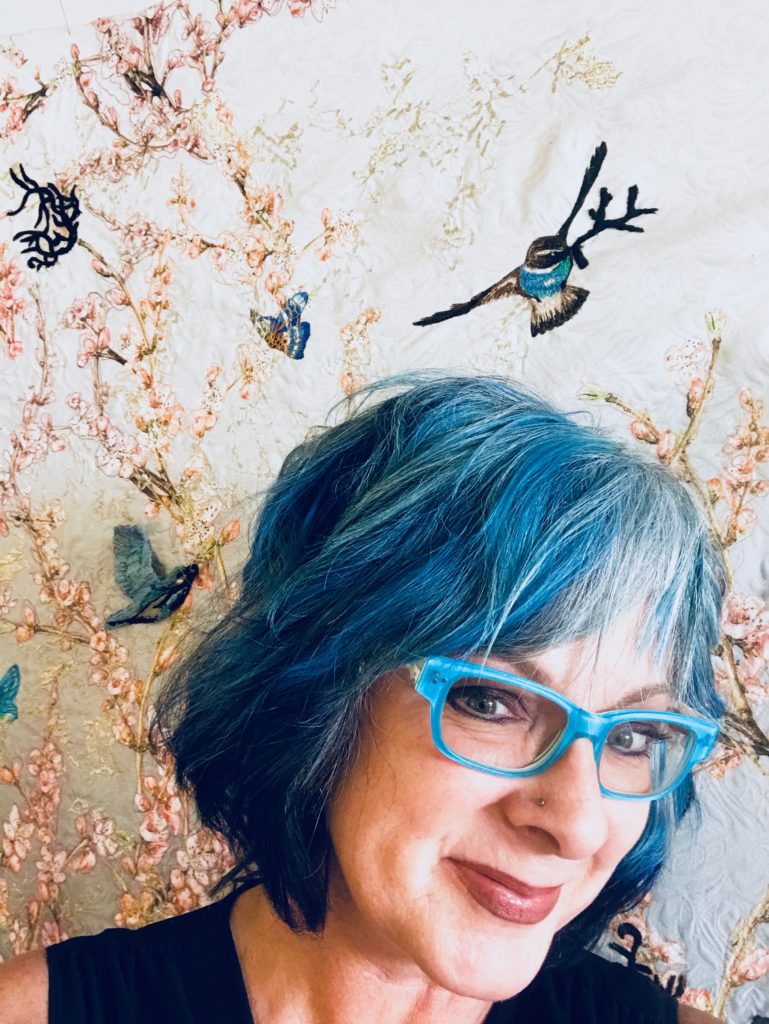
Artist Leisa Rich
LR: When I moved to Atlanta 12 years ago, there were significantly fewer opportunities for artists doing the kind of work I do with textiles and installations. I had to step out on my own in carve my own path. Through the years of experimentation and education, I have developed my personal style. Thankfully over the years, Atlanta has gained more and more opportunities for working artists. Today you see an art scene that features a broad variety of art mediums. Atlanta has become the home for artists in printmaking, painters, sculptures, and even street art, just to name a few.
CC: What inspires you to create?
LR: As a small child I was attached to a particular blanket that had a satin trim. I would self-soothe by running my fingers from one end to the other each night before falling asleep. I found a comfort with textiles that aided me in dealing with childhood illness and deafness. Throughout my upbringing, my parents taught me to be resourceful by reusing materials and instilled with me “do-it-yourself” kind of mentality. Both of my parents are products of the Great Depression and WWII — being creative with resources and the act of making was very natural in our home. By age 11 I learned to sew and created my first original art-to-wear piece.
Nature has also been an influence on my work. Growing up in Canada, surrounded by lakes and verdant forests, ice caves in which to hide in the winter, dripping icicles, shimmering water, and dappled sun, all impressed upon me the strong connection with the elements. This connection is reflected in the organic forms I often employ both in material and interactive installation pieces.
I am happy to be labeled as a “fiber artist,” for it is those materials and methods of handwork that hark back to the beginning of human survival. This skill clothed us and protected us from wind and rain. It is a skill that has transformed from necessity to practices such as weaving, knitting, and embroidery that led to more expressive ways of adorning and embellishing ourselves. I believe that these practices nurture the psyche and stimulate the senses. I seek to draw my viewer in to become a participant, a co-creator, and I aim to transport the audience into a world of my creation in order to “touch” them.
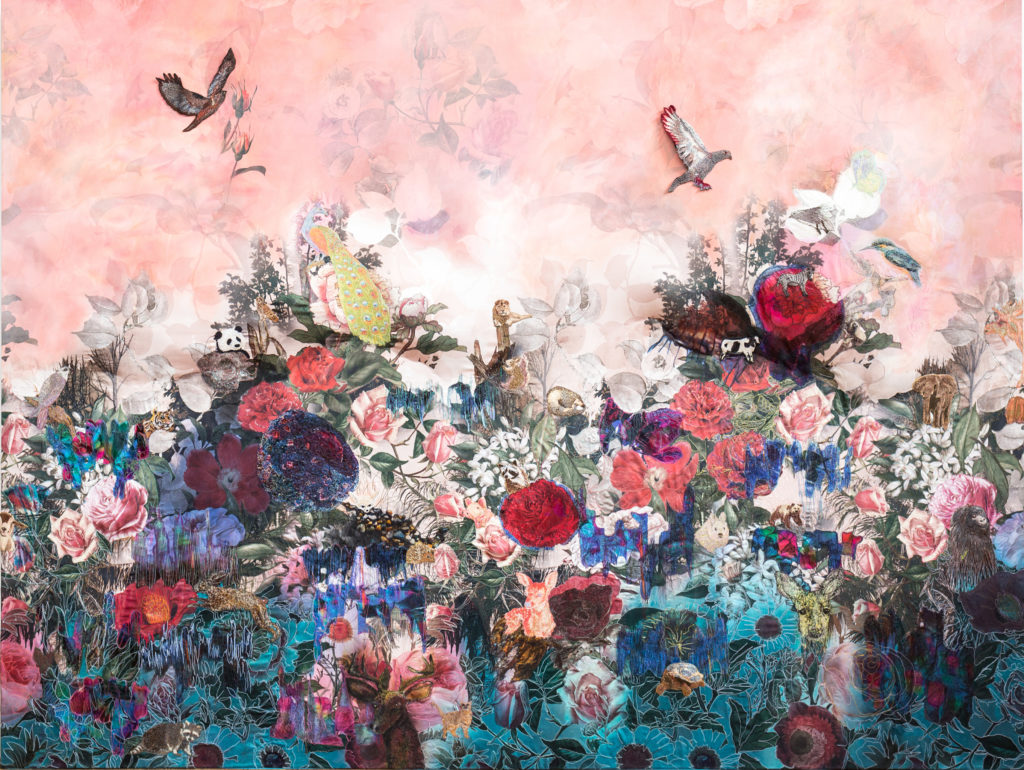
CC: How do you create harmony using a wide range of mediums?
LR: The moment I enter my studio, balance and harmony come into my soul. I am happiest in silence, and I can forget everything for hours as I work. The act of experimentation is extremely satisfying for me. There is a constant challenge in pushing a concept or material past its boundaries. I cannot repeat and do the same thing over and over and over again, however, I do recognize the value in that for other artists. Some critics might denigrate my work for that very ‘variety,’ but I feel that there is a thread running through everything I do, and those who are really familiar with my work recognize it and see the connection.
I used to listen to everyone and try to repeat, repeat, repeat to create their concept of a “body of work,” but I was desperately unhappy doing so, and as a result, the work suffered. When I reached my 50s I hit a wall and realized I had to stop listening to others and be true to myself. I have been much happier since, have had more opportunities open up to me, and have sold more work than previously as a result.
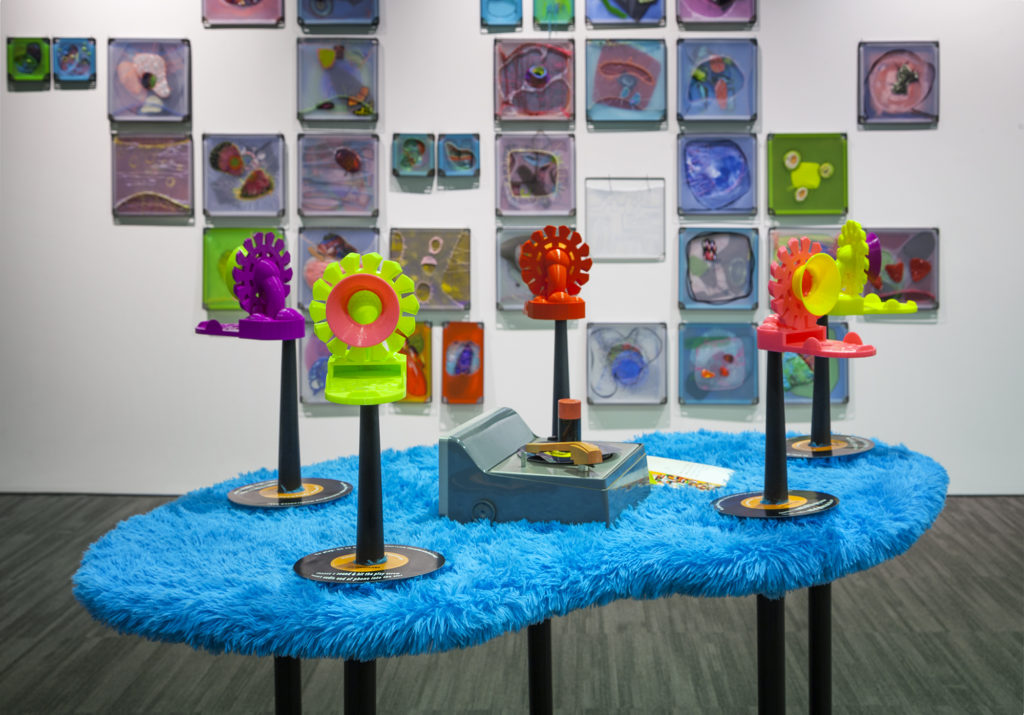
CC: Why did you start 3D printing?
LR: My interest was sparked after reading a few articles on 3D printing some years back. I shared the articles with my husband, who is a Futurist and also interested in exploring the medium. Both my husband and I were recent empty nesters and it became an activity that we could share together. We bought a 3D printer and began experimenting. I had, and have, no desire to create stand-alone 3D printed pieces.
For me 3D printing is a tool to combine with tactile, fiber art processes and materials to create interesting hybrids. I have also been designing and creating gramophones that have become communal sound systems to bring individuals together to use their cell phones in a communal activity.
CC: How has technology influenced your artwork?
LR: It may surprise people to know that I’m actually not very interested in tech in and of itself as some people are. I am more of a hands-on, tactile creator. Computers are the product of the weaving loom. I use computers to alter images for heat transfers as well as for other uses. A 3D printer helps me to quickly realize ideas for elements that enhance the concepts I have. I use sewing machines a great deal in my work via intensive stitching called Free Motion Machine Embroidery to put large elements together. Technology is one of the many tools I use to achieve my creative goals in my work.
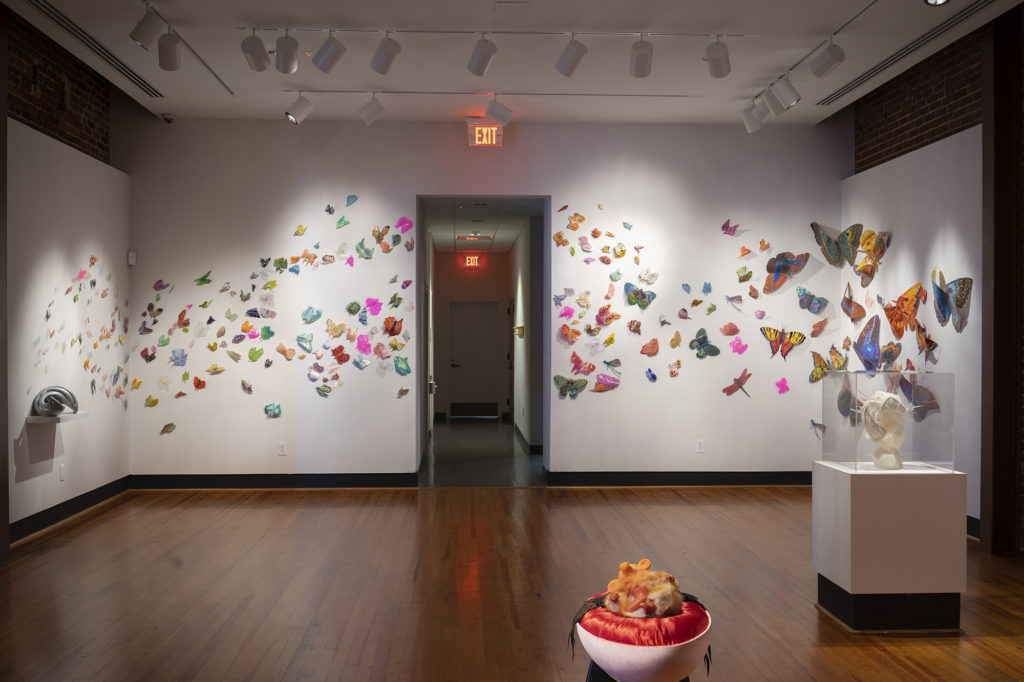
CC: What’s next for you?
LR: I’m embarking on large installations, wall-hung fiber art pieces, and sculptural elements for a unique solo exhibition in April 2019 at Thomas Deans Gallery’s stunning expanded gallery space. I am also sewing and handpainting thousands of butterflies to create a Lepidoptera for the ArtFields 2019 competition in Lake City, South Carolina, also in April. I have a show coming up of my flowered, heavily stitched wall works in 2019 at Signature Gallery. I have several weeks of teaching in Australia, Washington state, and Arrowmont. I’m also working on a book about a unique material that I actively use. I received a Fellowship from Fulton County Arts Council to work at Hambidge in the spring. We’ll see what else comes along!
See more of Leia’s work on her portfolio site, Instagram, and Facebook.





